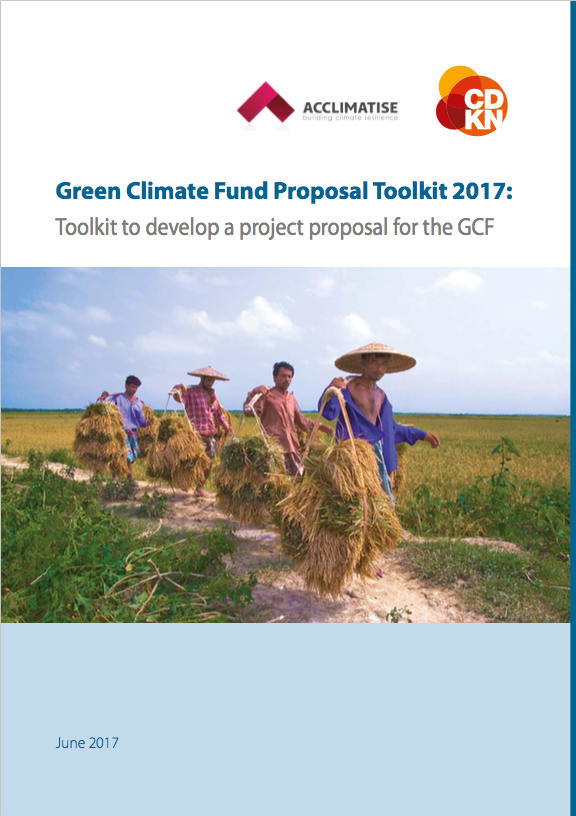Green Climate Fund Proposal Toolkit

Introduction
Responding to climate change challenges requires collective action from all countries, governments, cities, communities, businesses and private citizens. With US$10.3 billion currently pledged, the Green Climate Fund (GCF) is the world’s largest fund dedicated to the fight against climate change. Designed to be the main financial instrument to mobilise US$100 billion per year by 2020 from both public and private sources, the GCF is the centrepiece to address the pressing mitigation and adaptation needs of developing countries.
This toolkit* aims to guide project proponents’ understanding of the key considerations to take into account to fulfil the GCF’s requirements when developing funding proposals.
*Download the full toolkit form the right-hand column.
What does the GCF support?
The GCF aims to support developing countries in achieving a paradigm shift to low-emission and climate-resilient pathways. This is achieved by funding innovative and transformative low-emission (mitigation) and climate-resilient (adaptation) projects and programmes developed by the public and private sectors to contribute to the implementation of national climate change priorities in developing countries. While it is relatively easy to tell what a mitigation project or programme is (i.e. its contribution to the reduction of greenhouse gases in the atmosphere, and/or whether it increases the capacity of an ecosystem to absorb them), the blurred line between a general development project and an adaptation project has been a contentious issue in the international climate nance debate, including at GCF Board meetings. The relevant question is not whether a project is (also) a development project, but whether the project contributes to adaptation (i.e. what the adaptation/additionality argument is). Cross-cutting projects that deliver co-benefits in terms of both mitigation and adaptation are also eligible for funding.
In the toolkit
- Essentials to know before developing a GCF project:
- What does the GCF support?
- How much and what type of finance is available?
- What are the roles of different actors?
- What about the private sector?
- Key Project design elements:
- Results Management Framework
- Interim Environmental and Social Safeguards
- Gender Policy
- The GCF proposal template
- How to put together a GCF funding proposal: a stepwise approach
- Step 1: How to define the project scope?
- Step 2: How to develop a logic framework?
- Step 3: How to access project risks and identify mitigation measures?
- Step 4: How to integrate gender into a project?
- Step 5: How to assign indicators to measure progress?
- Step 6: How to align a project against the GCF investment criteria?
- Step 7: How to identify the rationale for GCF involvement?
- Step 8: How to monitor, evaluate and report on a project?
- Step 9: How to prepare a budget for your project?
- Step 10: How to justify the level of concessionality of a project?
-
The GCF project cycle
-
How to get started?
-
Support available for the full proposal preparation.
What makes a good GCF project?
A good GCF (adaptation, mitigation or cross-cutting) project or programme should demonstrate how it will contribute to achieving a paradigm shift to a country’s low-emission and climate-resilient development pathway. To demonstrate this, project proponents should:
- Ensure their funding proposal describes a long-term vision through its theory of change and how this can be achieved through short-, medium- and long-term changes, including by supporting systemic shifts through strategic investments in regulatory and policy actions that have the potential to change behaviour in markets and economies beyond one-o investments.
- Promote country ownership through alignment with national climate change priorities and comprehensive consultation and engagement with all relevant stakeholders, including the National Designation Authority (NDA) the target group (especially vulnerable communities, women, minority groups, etc.), government staff from different ministries or departments, other relevant organisations and sector experts.
- Embed long-term sustainability in the project or programme’s design to ensure its impacts will be sustained after financial support from the GCF and other funding sources runs out.
- Demonstrate value for money and, where possible, secure up-front co- financing to encourage crowding in, that is, stimulating long-term investments beyond the GCF resources and the up-front commitments.
Get ‘Climate Finance Ready’
This work is part of a series of publications aiming to support climate finance readiness. Find out more on the Climate Finance Ready website, run by the Adaptation Fund and CDKN to foster ongoing dialogue and collaboration: https://climatefinanceready.org/
Suggested Citation
Fayolle, V. and Odianose, S. (2017) Green Climate Fund Proposal toolkit 2017. London: Acclimatise and Climate and Development Knowledge Network.
Acknowledgements
The authors thank Areej Riaz from CDKN, Virginie Le Masson and Mairi Dupar from the Overseas Development Institute (ODI), and Emma Doherty and Jim Stephenson from PricewaterhouseCoopers (PwC).
This toolkit was developed in close collaboration with the GCF Secretariat and was reviewed by two Accredited Entities – the National Bank for Agriculture and Rural Development (NABARD), India, and the Peruvian Trust Fund for National Parks and Protected Areas (PROFONANPE), Peru, which were successful in having their projects funded by the GCF.
(0) Comments
There is no content